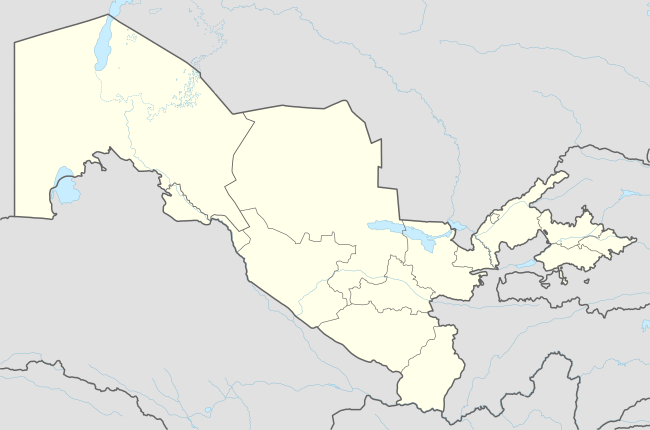Kokand
Kokand (Uzbek: Qo‘qon, Қўқон, قوقان; Russian: Кока́нд; Persian: خوقند, romanized: Xuqand; Chagatai: خوقند, Xuqand; Kyrgyz: Кокон, romanized: Kokon; Tajik: Хӯқанд, romanized: Xökand) is a city in Fergana Region in eastern Uzbekistan, at the southwestern edge of the Fergana Valley. The population of Kokand on April 24, 2014 was approximately 187,477. The city lies 228 km (142 mi) southeast of Tashkent, 115 km (71 mi) west of Andijan, and 88 km (55 mi) west of Fergana. It is nicknamed "City of Winds", or sometimes "Town of the Boar". Kokand's name derives from the well-known tribal family group of "Kokan" who belong to the Kongrat tribe of Uzbeks.[1]
Kokand Qo‘qon / Қўқон | |
|---|---|
.jpg) .jpg)  | |
 Kokand Location in Uzbekistan | |
| Coordinates: 40°31′43″N 70°56′33″E | |
| Country | |
| Region | Fergana Region |
| Government | |
| • Hokim | Ma'rufjon Usmonov |
| Area | |
| • Total | 40 km2 (20 sq mi) |
| Elevation | 409 m (1,342 ft) |
| Population (2016) | |
| • Total | 239,900 |
| • Density | 6,000/km2 (16,000/sq mi) |
| Time zone | +5 |
| Postal code | 150700 |
| Website | kokand |
Kokand is at the crossroads of the two main ancient trade routes into the Fergana Valley, one leading northwest over the mountains to Tashkent, and the other west through Khujand. As a result, Kokand is the main transportation junction in the Fergana Valley.
History
Kokand has existed since at least the 10th century, under the name of Khavakand, and was frequently mentioned in traveler's accounts of the caravan route between South Asia and East Asia. The Han Dynasty of China conquered the entire city in the 1st Century B.C. Later, the Arabs reconquered the region from Tang Empire. The Mongols destroyed Kokand in the 13th century.
The present city began as a fort in 1732 on the site of another older fortress called Eski-Kurgan. In 1740, it became the capital of an Uzbek kingdom, the Khanate of Kokand, which reached as far as Kyzylorda to the west and Bishkek to the northeast. Kokand was also the major religious center of the Fergana Valley, boasting more than 300 mosques.
Imperial forces of Russian Empire under Mikhail Skobelev captured the city in 1883 which then became part of Russian Turkistan. After joining of Kokand and the whole of Central Asia, in general, to the Empire, peace and order came to the region for 40 years. During World War I, two revolutions happened in the Russian Empire. Separatists took advantage of the situation to destabilize the city and to prevent revolutionary changes. So it was the capital of the short-lived (72 days) (1917–18) anti-Bolshevik Provisional Government of Autonomous Turkistan (also known as Kokand Autonomy).[2] They sought co-operation from Ataman Dutov and Alash Orda. However, their emissary to the Amir of Bukhara achieved little.
It is worth to note that the modern city was mainly developed since its joining to Russian Turkistan.
Main sights
- The Palace of Khudayar Khan was built between 1863 and 1874 by Muhammad Khudayar Khan. Upon completion, it was one of the largest and most opulent palaces in Central Asia. Nineteen of its original one hundred and thirteen rooms survive and now host a museum.
- Jummi Mosque (right), a Friday mosque built in 1800–1812, and reopened in 1989, it can hold 10,000 worshipers.
- Amin Beg Madrassah, built in 1813.
- Dakhma-I-Shokhon, a necropolis of the Kokand Khans from the 1830s.
- Khamza Museum, dedicated to Kokand's Soviet hero Hamza Hakimzade Niyazi.
Education and culture
A number of madrasah can be found with the city. Kokand made contribution to Islam. It is also home to a number of notable hanafi scholars, such as Abdulhafiz Al-Quqoniy and Yorqinjon Qori Al-Quqoniy.
There are 2 institutes, 9 colleges and lyceums, 40 secondary schools, 5 musical schools, a theater, and 20 libraries. There are 7 historical and house museums located in Kokand.[3]
Economy
The black market provides nearly 75% of the income generated in the borders of the city. This includes retail, groceries, employment, money exchange, agriculture and manufacturing of many goods. A large part of the population works as small business owners in outdoor markets.
Kokand is a center for the manufacture of fertilizers, chemicals, machinery, and cotton and food products. Over the last two decades, new districts and public buildings have been created in the city as well as many houses, shops, cafes, restaurants and other private sector ventures. Kokand is an education center with one institute, nine colleges and lyceums, and numerous museums.
Notable people
- Muhammad Sharif Gulkhani, poet and satirist
- Ziroatkhon Hoshimova, First Lady of Uzbekistan
- Ida Mayrin (born 1997), Israeli Olympic rhythmic gymnast
- Yodgor Nasriddinova, Uzbek-Soviet engineer and communist party official
- Abdulla Qahhor, Uzbek writer
- Abraham Resnick, rabbi
References
- Географические названия мира: Топонимический словарь. — М: АСТ. Поспелов Е.М. 2001.
- The Politics of Muslim Cultural Reform, Jadidism in Central Asia by Adeeb Khalid, Oxford University Press, 2000
- More on Kokand